

Original Article - Year 2016 - Volume 31 -
Z-plasty: a comparative study between theoretical and practical elongation
Zetaplastia: estudo comparativo entre o alongamento teórico versus prático
ABSTRACT
INTRODUCTION: The study of the final elongation values produced by 45º, 60º, 75º, and 90º-angle z-plasties performed on the skin of the lower abdomen of fresh cadavers were compared with the theoretical mathematical data published in the literature.
METHODS: Four z-plasties with 2-cm main and secondary branches each, and with 45º, 60º, 75º, and 90º angles were performed on the skin of the lower abdomen in 11 fresh cadavers to evaluate the final elongation produced.
RESULTS: The mean elongation at their respective angles was lower than that found in the literature, with a p value of <0.01.
CONCLUSION: The elongation values obtained from the present study showed a significant difference from the published values.
Keywords: Surgical flaps; Comparative research on effectiveness; Measures methods and theories; Comparative study; Theoretical models; Abdomen.
RESUMO
INTRODUÇÃO: O estudo do alongamento final produzido por zetaplastias com ângulos de 45, 60, 75 e 90 graus na pele do abdome inferior de cadáveres frescos foi comparado com os dados matemáticos teóricos apresentados pela literatura.
MÉTODOS: Foram realizadas quatro zetaplastias com ramos principais e secundários de 2 cm cada um deles e ângulos de 45, 60, 75 e 90 graus na pele do abdome inferior de 11 cadáveres frescos para avaliar o alongamento final produzido.
RESULTADOS: A média dos alongamentos para os respectivos ângulos foi inferior ao encontrado na literatura, com valor de p < 0,01.
CONCLUSÃO: Existiu diferença significativa entre os valores da literatura e os encontrados no presente estudo.
Palavras-chave: Retalhos cirúrgicos; Pesquisa comparativa da efetividade; Medidas métodos e teorias; Estudo comparativo; Modelos teóricos; Abdome.
Z-plasty is a surgical technique used in the correction of unsightly scars. The main objective is to promote the stretching of the scar to form a broken line, a technique used in cicatricial contractures and reparative surgery1. The basic principle consists of two adjacent triangular flaps that form a Z and are interpolated to perform a z-plasty.
The first description of z-plasty in the literature was by Horner2 in 1837. According to Borges3, after z-plasty, the scar is divided into smaller compartments, which results in a lower contracture force than that in a linear scar. In trigonometry studies, McGregor4 reported that by increasing the Z angle, the stretching of the final scar also increases.
According to Cárdenas5, the elongation produced by z-plasty is determined mathematically in percentages by linear stretching. Z-plasties with 45º, 60º, 75º, and 90º angles have a final theoretical mathematical elongation of 50%, 75%, 100%, and 120%, respectively6. However, according to Basci and Gosman7, the final resulting elongation in human skin is 55% to 84% shorter than estimated.
OBJECTIVE
The objective of this study was to compare the final elongation values obtained through 45º, 60º, 75º, and 90º-angle z-plasties performed on the skin of fresh cadavers with the theoretical mathematical data published in the current literature.
METHODS
Z-plasties with angles of 45º, 60º, 75º, and 90º were performed in fresh cadavers from the University of São Paulo, Death Surveillance Service of the Capital São Paulo (SVOC-USP), from June 2014 to December 2015. Eleven cadavers (five females and six males) were selected, with ages ranging from 32 to 75 years (mean, 56 years). Authorization to study using cadavers was given by Decisions 42/2014 and 05/2015 of SVOC-USP.
The abdominal midline was drawn from the xiphoid appendix to the pubic symphysis. A point 20 cm from the xiphoid appendix was demarcated on the abdominal midline. At this point, another 20-cm dotted line was drawn perpendicular to and centered on the abdominal midline (Figure 1A and 1B).

Figure 1. A: Xiphoid pubic abdominal midline; B: Dotted line perpendicular to the abdominal midline.
Four z-plasties with 45º, 60º, 75º, and 90º opening angles were made on the dotted line (Figure 2). The z-plasties were drawn 4 cm equidistant from each other, with main branches 2 cm long. The two secondary branches resulted from the application of the same opening angle at the ends of the main branch and measure 2 cm each. The accuracy of the angle used in each z-plasty was assessed by using a millimeter ruler and protractor.
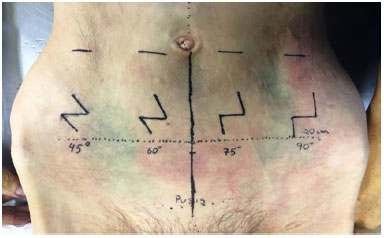
Figure 2. Arrangement of the angles in the lower abdomen.
After marking the four z-plasties, in the same cadaver, incisions involving the skin thickness (Figure 3A and 3B) were made on the line perpendicular to the median line. The triangular flaps thus formed were raised without the subcutaneous tissue, interpolated, and sutured.
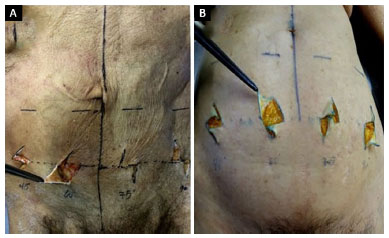
Figure 3. A and B: Triangular skin flaps.
By using a millimeter ruler, the initial elongation was determined based on the length of the main branch before z-plasty, and the final elongation was determined based on the length of the main branch formed after z-plasty (Figure 4A and 4B).
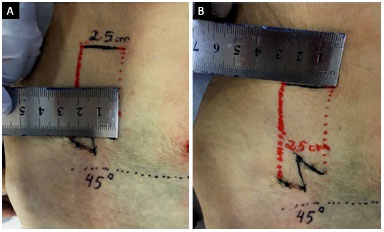
Figure 4. A and B: Final elongation after interpolation of the triangular flaps to a 45º angle.
The initial elongation was transported 7 cm above the perpendicular line so that tissue distortions after z-plasty did not interfere with the measurement of the resulting elongation (Figures 5A, 5B, 6A, 6B, 7A, and 7B).
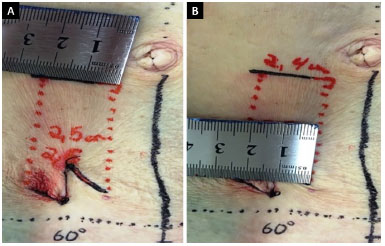
Figure 5. A and B: Final elongation after interpolation of the triangular flaps to a 60º angle.
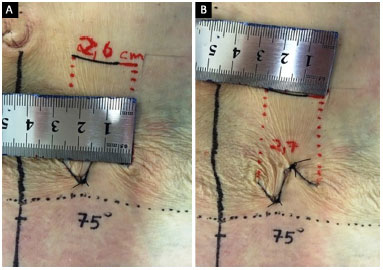
Figure 6. A and B: Final elongation after interpolation of the triangular flaps to a 75º angle.
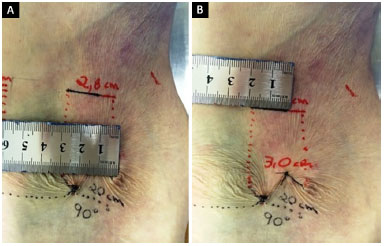
Figure 7. A and B: Final elongation after interpolation of the triangular flaps to a 90º angle.
The data of the final and original measurements were submitted for statistical analysis using the confidence interval (CI) test for mean, setting the significance level at p < 0.05. Repeated-measures analysis of variance (ANOVA) was used to compare the elongation measured in this study with the theoretical data.
RESULTS
The final elongation values produced after transposition of the triangular flaps were shorter than the theoretical mathematical data obtained from z-plasties reported in the literature (Table 1). All the angles studied were analyzed by using the Student t test, with a p value of <0.01. Table 2 shows the distribution of the elongation values produced by using the application of the angles in the 11 cadavers.
The mean elongation for the 45º-angle z-plasty was 21.4%, with 95% CIs between 18.3% and 24.4%. The 60º-angle z-plasty displayed a mean elongation of 34.09%, with 95% CIs ranging from 27.9% to 40.3%. The 75º-angle z-plasty resulted in a mean elongation of 52.3%, with a 95% CI ranging from 39.4% to 65.1%. The mean elongation value of the 90º-angle z-plasty was 74.1%, with 95% CIs ranging from 55.1% to 93.1%.
The ANOVA comparative test resulted in a p value of 0.0135 for p < 0.05, indicating a significant difference between the means of the angles obtained and the theoretical values. This was confirmed by using the Tukey test, with a p value of <0.05 for each angle.
DISCUSSION
The mathematical values published in the literature were obtained without taking into account the physical properties of the skin. Variations in thickness, number of attachments, and tissue redundancy adjacent to the z-plasty may also alter the interpolation of triangular flaps. The cicatricial maturation process as an individual characteristic also could not be reproduced in this study because it was performed on the normal skin of fresh cadavers.
The 45º-angle z-plasty showed a shorter final mean elongation value than the published mathematical calculations with a mean of 21.4%, with the expected mean being 50%8. Even the practical data presented by Basci and Gosman7, who estimated an elongation between 55% and 84% of the mathematical calculations published in the literature, do not coincide with the measurements obtained from cadavers.
Taking into consideration that the elongation for an angle of 60º is 75%9, the same angle on the fresh cadaver displayed a mean elongation of 34.9%. The mean elongation was shorter than the mathematical calculations and practical information defined by Basci and Gosman7.
The 75º angle behaves in a similar manner, with a mean percentage of 100%10 and a mean elongation of 52.3% in fresh cadavers. This value is slightly below the minimum of 55% determined by Basci and Gosman7.
The mean elongation produced by the 90º-angle z-plasty estimated mathematically was 120%, higher than that found in this study, where the mean elongation for the 90º angle was 74.1%. This was the only angle coincident with the interval recommended by Basci and Gosman7.
The comparative ANOVA test yielded a significant difference in the comparison between the angles and the mathematical data, demonstrating that the data in the literature do not agree with the data obtained from the fresh cadavers in this study.
The final elongation values obtained from the fresh cadavers with the 45º, 60º, 75º and 90º-angle z-plasties in this study were shorter values than the mathematical calculations found in the literature.
CONCLUSION
Z-plasties with 45º, 60º, 75º, and 90º angles performed on the skin of the lower abdomen of fresh cadavers yielded shorter mean final elongation values than the theoretical mathematical calculations presented in the literature. Statistical analysis of the data by using 95% Cis, the Student t test, and ANOVA showed a significant difference between the values presented in the literature and the mean values obtained in this study.
COLLABORATIONS
FCL Analysis and/or interpretation of data; statistical analysis; final approval of the manuscript; conception and design of the study; completion of operations and/or experiments; and drafting the manuscript or critical review of its contents.
BPL Analysis and/or interpretation of data and completion of operations and/or experiments.
GAL Completion of operations and/or experiments.
TPAA Completion of operations and/or experiments and drafting the manuscript or critical review of its contents.
ACA Final approval of the manuscript; conception and design of the study; and drafting the manuscript or critical review of its contents.
REFERENCES
1. Amaral AB, Rosique RG. Correção das cicatrizes. In: Melega JM, Viterbo F, Mendes FH, eds. Cirurgia plástica: os princípios e a atualidade. Rio de Janeiro: Guanabara Koogan; 2011. p. 143-9.
2. Pacheco A, Webser R, Terres M, Netto R. Princípios da utilização de retalhos cutâneos e fasciocutâneos. In: Carreirão S, ed. Cirurgia plástica para a formação do especialista. São Paulo: Atheneu; 2011. p. 117-8.
3. Cárdenas HV. Z-Plastia e w-plastia no tratamento de cicatrizes inestéticas: revisão bibliográfica [Monografia]. Niterói: Universidade Federal Fluminense; 2005. p. 6-49.
4. Jackson IT. Considerações Gerais. In: Jackson IT, ed. Retalhos locais na reconstrução de cabeça e pescoço. Rio de Janeiro: DiLivros; 2015. p. 26-7.
5. Lynch JB. Retalhos. In: Brown DL, Borschel GH, eds. Manual de cirurgia plástica de Michigan. Rio de Janeiro: DiLivros; 2006. p.27-9.
6. Lorenz P, Bari AS. Prevenção de cicatriz, tratamento e correção. In: Neligan PC, Gurtner GC, eds. Cirurgia Plástica: Princípios. Rio de Janeiro: Elsevier; 2015.
7. Basci D, Gosman AA. Fundamentos dos retalhos. In: Janis JE, ed. Cirurgia plástica princípios básicos. Rio de Janeiro: DiLivros; 2015. p. 32-33.
8. Torres FC, Mauad Junior RJ. Princípios gerais da cicatrização das feridas e suturas de pele. In: Carreirão S, ed. Cirurgia plástica para a formação do especialista. São Paulo: Atheneu; 2011. p. 3-13.
9. Anger J, Sertorio CB. Avaliação das medidas do alongamento do lábio nas queiloplastias com plástica em Z no tratamento das fissuras labiopalatais unilaterais. Rev Bras Cir Plást. 2006;21(3):133-9.
10. Thorne CH. Princípios e técnicas em cirurgia plástica. In: Thorne CH, Ed. Grabb & Smith Cirurgia Plástica. Rio de Janeiro: Guanabara Koogan; 2007, p.13.
11. Krish A, Schindler E. Application possibilities of symmetrical and asymmetrical serial Z plasty for correction of facial and neck scars. Laryngol Rhinol Otol (Sttuttg). 1981;60(6):318-20.
1. A.C.A. Grupo Integrado de Assistência em Cirurgia Plástica de São Paulo, São Paulo, SP, Brazil
2. Sociedade Brasileira de Cirurgia Plástica, São Paulo, SP, Brazil
Institution: A.C.A. Grupo Integrado de Assistência em Cirurgia Plástica de São Paulo, SP, Brazil.
Corresponding author:
Flavia Carnovale Lima
Rua Geraldo Lopes, 26 - Jardim Residencial Suzano
Suzano, SP, Brazil Zip Code 08615-520
E-mail: flaviacarnovale@hotmail.com
Article received: June 30, 2016.
Article accepted: October 30, 2016.
Conflicts of interest: none.



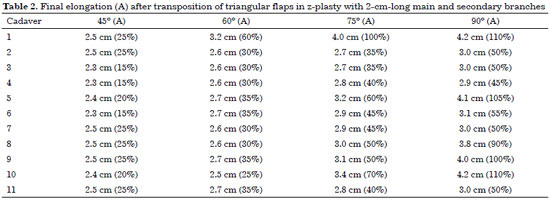
 Read in Portuguese
Read in Portuguese
 Read in English
Read in English
 PDF PT
PDF PT
 Print
Print
 Send this article by email
Send this article by email
 How to Cite
How to Cite
 Mendeley
Mendeley
 Pocket
Pocket
 Twitter
Twitter